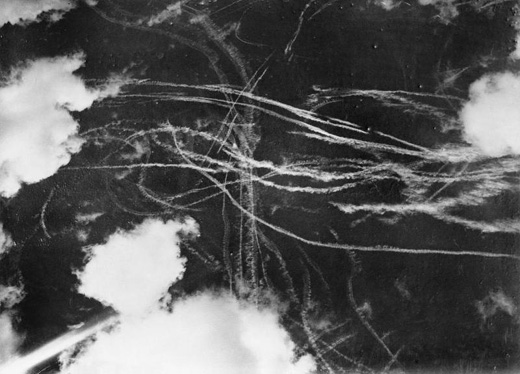Battle of Britain
Day 71
Weather - Wind and showers with occasional bright intervals.
Combat - At about 0900hrs a raid of 150 Me-109's is plotted approaching the Kent coast. Fighter Command scrambles fifteen squadrons to intercept but only the Hurricanes of No: 501 Squadron, from Kenley and Spitfires of No: 72 and 92 (both from Biggin Hill), No: 41 and 603 (both from Hornchurch) and No: 19 (from Duxford) Squadrons successfully manage to engage the raiders.
Condensation Trails Over Kent |
 |
Just after 1230hrs a large raid, consisting of Ju-88's Me-109's, crosses the coast near Dover heading directly towards Maidstone and London. Shortly after another wave of Ju-88's heads along the east coast of Kent towards the Thames Estuary area. As the raiders approach London and Gravesend areas the Hurricanes of No: 17, 46 and 501 Squadrons along with Spitfires of No: 41 and 66 Squadrons intercept, causing the bomber formations to break up. As bitter aerial battles develop the Hurricanes (No: 242, 302 and 310 Squadrons) and Spitfires (19 & 611 Squadrons) of the Duxford Wing dive into the bombers inflicting further losses.
From 1545hrs to around 1630hrs several waves of Ju-88's and Me109's cross the coast at Dover, Deal and Thames Estuary areas. Hurricanes of No: 17 and 302 Squadrons and Spitfires of No: 66 and 92 Squadrons scramble to engage the enemy over the Thames and East Kent.
During the night heavy raids are made on London with further bombs dropping on Liverpool, areas of the North East, Bristol and Humber areas.
R.A.F. Losses: 20 aircraft damaged or destroyed, 2 pilots killed and 6 wounded.
Luftwaffe Losses: 27 aircraft damaged or destroyed, 41 pilots & aircrew killed or missing and 7 wounded.
[NOTE: Losses include non-combat patrols and accidents.
Battle of the Atlantic
- British bombing sinks the German steamer Johann Blumenthal (1626t) at Cherbourg.
- U-48 sinks the British steamers City of Benares (11,081t) and Marina (5088t) from Convoy OB-213 about 250 miles west-southwest of Rockall. 119 crew and 134 passengers are lost from a crew of 207 and a total of 191 passengers, some children being evacuated to Canada. 2 crewmen are lost from the Marina. The British destroyer Hurricane picks up the survivors of both ships.
- U-48 sinks the British steamer Magdalena (3118t) south of Iceland. The entire crew of 31 are lost.
- The Swedish steamer Frisia (1059t) is seized by German forces at Bordeaux.
The Blitz
A major daylight raid hits London. Fire brigades tackle more than 1,000 fires. Liverpool is bombed by the Luftwaffe.
[Mediterranean
The Italian submarine Bagnolini sinks the Spanish steamer Cabo Tortosa (3302t) near Oporto. The entire crew is rescued by the Spanish steamer Monte Ayala.
[North Africa
The advance of the Italian 10th Army comes to a halt near Sidi Barrani, officially because of supply difficulties. They occupy themselves building various fortified camps and make little effort to keep in touch with the British forces which have pulled back before their superior strength.
[